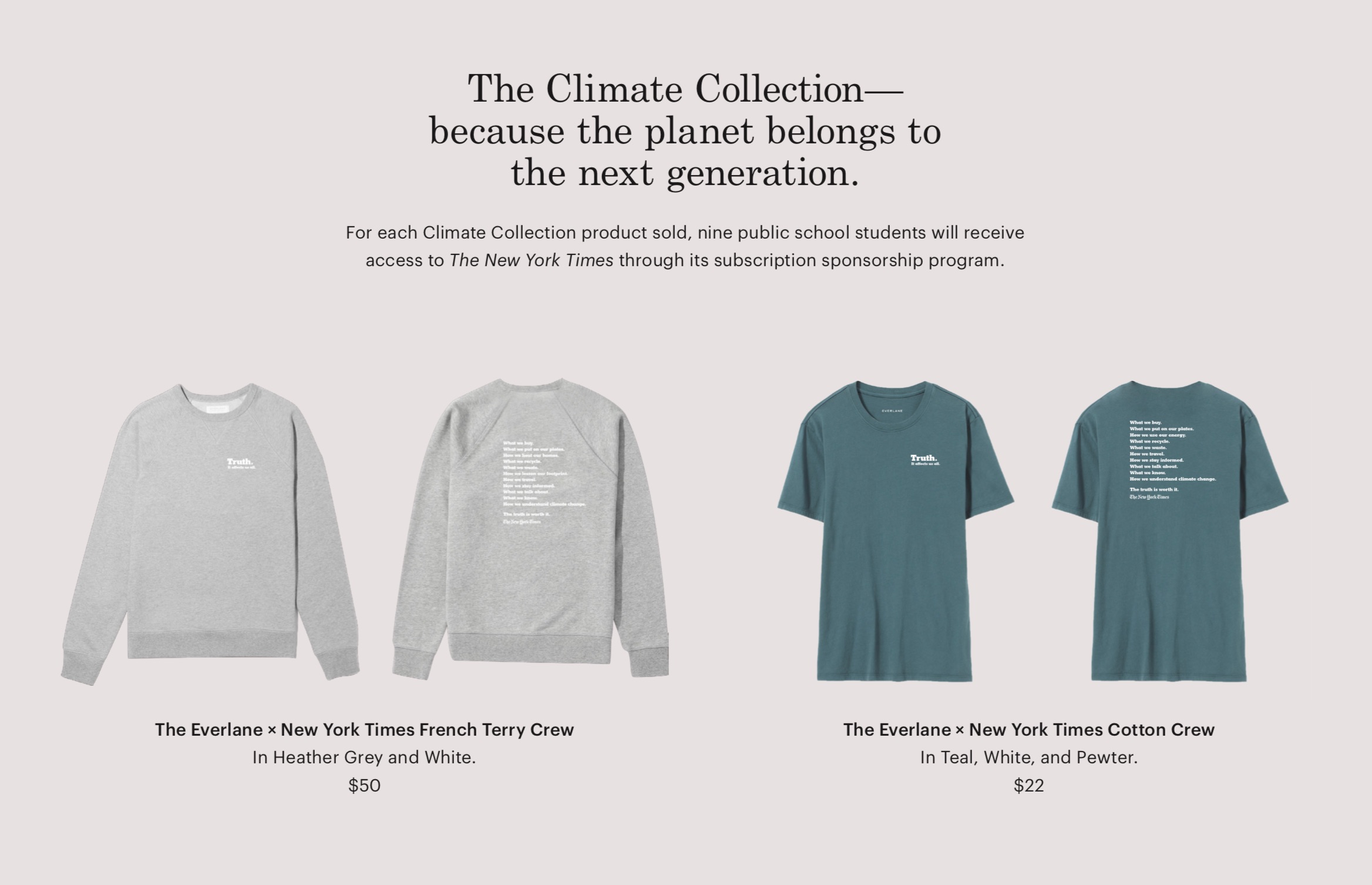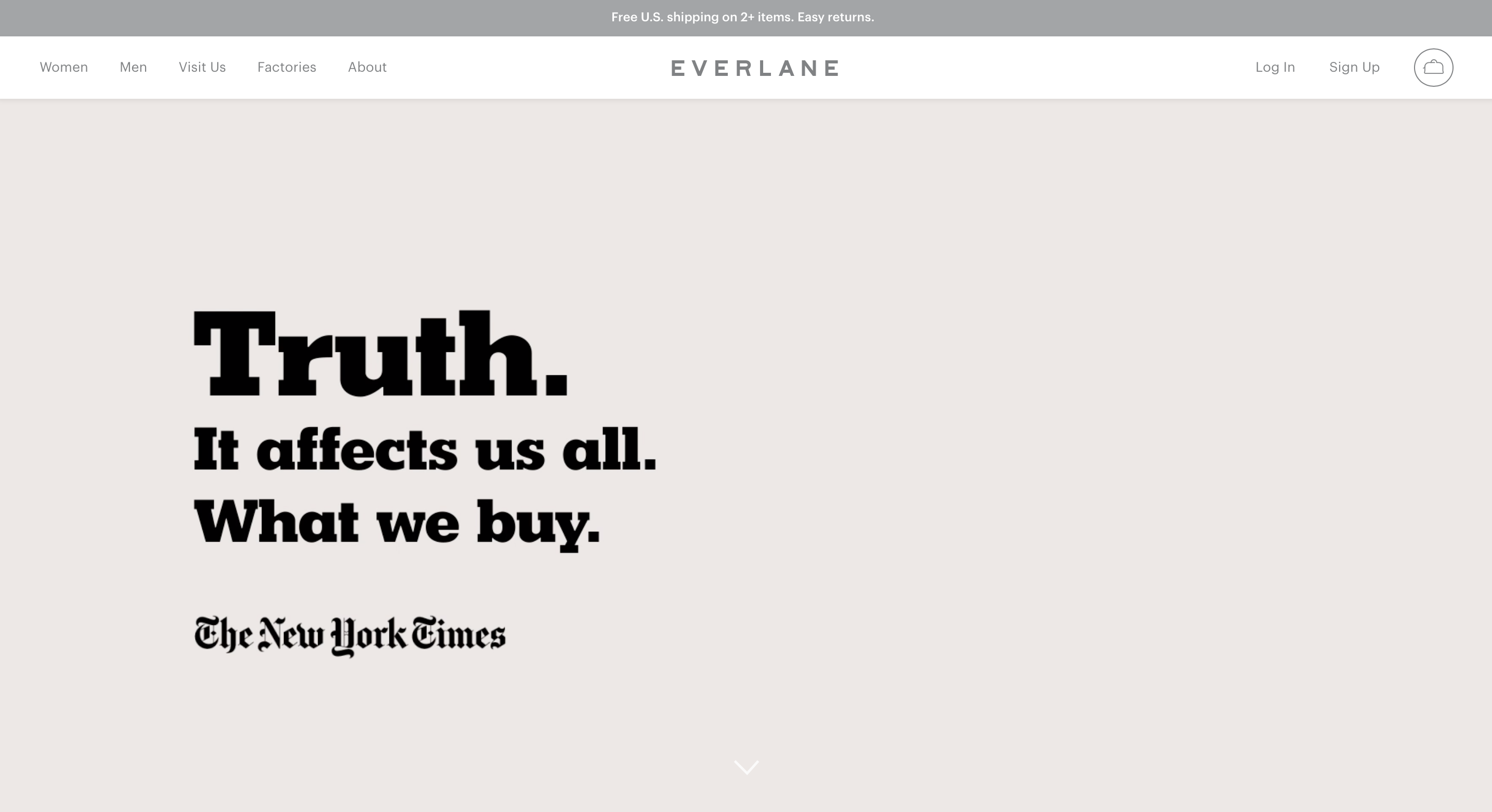
The conventional wisdom has long been that advertisers aren’t keen to pitch their wares next to hard news, huge catastrophes, or anything else that could make a target consumer bummed about the state of humanity when they should be contemplating the New! Shaving! Revolution! that Unilever now has the privilege of bringing you. As CNN’s Meredith Artley put it in a speech last year: “In these turbulent times, advertisers might not want to be associated with news that is just bad. You can kinda understand that.”
But now — thanks to the odd way that corporations and performative wokeness braid into the tapestry of 21st-century consumer capitalism — one fashion brand is teaming up with The New York Times to sell t-shirts, celebrate journalism, save the world from climate change, or all of the above.

The fashion brand is Everlane, and today it announced the New York Times Climate Collection: a t-shirt and a sweatshirt (pardon, a “French Terry Crew”), each emblazoned with recent Times marketing messages about the value of truth and one mention of the phrase “climate change” on the back. For every piece sold — $22 for the t-shirt, $50 for the sweatshirt — the Times will give nine high school students free access to NYTimes.com for a year, which of course costs the Times roughly zero dollars, but which nonetheless gives meaning to the second half of Everlane’s pitch:
Show your support for the truth—
and help inspire a future generation.
Everlane, founded in 2010, offers “luxury essentials,” which isn’t far from how the Times pitches $15-a-month subscriptions to a better quality of news than you can get on Facebook, the clear Old Navy in this analogy. “Classic cashmere sweaters, muted dress shirts, and Italian leather wallets”: That’s the weekday wardrobe of the market segment the Times most wants to reach, the educated upper-middle class. (Everlane says 95 percent of its customers have at least some college education.)
It’s not quite the socioeconomic tier that the Times’ use-this-tax-break-to-buy-yourself-a-plane service journalism is aimed at. But there are a lot more people in that Everlane tier.
And like the Times, Everlane sells its goods via a handful of aspirational values — transparency, ethics, environmental responsibility, capital-t Truth. And it makes the narrative of the consumer good’s path from Ho Chi Minh City factory to your UPS guy an intrinsic part of the packaging. (Times Insider is the newspaper’s equivalent of “We source our Grade-A cashmere from Inner Mongolia.”)

Here’s how Everlane’s marketing team describes the partnership:
Since its early days, Everlane has been committed to transparency and educating consumers on the facts — from true cost breakdowns and factory practices to sustainability struggles in the retail industry. The New York Times has set journalistic standards by tirelessly seeking the truth and helps make even the most complex topics understandable. This Earth Day, the two brands are working together — through a product partnership and Everlane site experience that highlights groundbreaking Times reporting — to shine a light on the most important story of our time: climate change.
I’m not sure where the Everlane Climate Collection French Terry Crew will end up on the Media Merch Cultural Signification Rankings — my guess is below “New Yorker tote bag” but ahead of “BuzzFeed ‘Hey there demons, it’s me, ya boi’ shirt.” But it’s a reminder that — as geographically driven mass media has given way to psychographically driven digital media — even the newsiest of news organizations are also lifestyle brands. New York Times superfans can now literally clothe themselves in the drapery of upmarket coastal liberalism.

Look, I love The New York Times, my wife says she likes this one Everlane shirt that she has, climate change is the defining crisis of our lifetimes, and everyone here seems well-intentioned. But while plenty of media products have long based their audience relationships on a sense of shared values and meaning, it’s still a sort of uncomfortable place for a newspaper of record to be.
To the extent that newspapers marketed themselves to readers in the past — and they often didn’t do much — it was typically around some promise of utility. $200 of coupons every Sunday! Read the news everyone will be talking about! Late baseball scores, closing stock prices, plan your weekend, news you can use!
But the most utilitarian parts of the old newspaper package have been stripped away, by Craigslist, Yelp, Facebook, Google, ESPN, Groupon, and the rest. The newsy core that remains is harder to pitch on usefulness — but for a certain kind of conscious consumer, it can be pitched on values and meaning. And millennials keep telling consumer researchers that they want values-driven brands, ethical brands, sustainable brands, fair-trade brands, green brands, cruelty-free brands. That kind of search for consumerist meaning is what leads to a Heather Grey French Terry Crew advertising Truth.
Back when the 2016 presidential campaign was still in its early stages, Meredith Kopit Levein, the Times’ chief operating officer, came to a realization. “We needed to start thinking about The New York Times as a consumer brand, and take its power as a brand much more seriously,” she told AdAge later. “There was always this sense that we had this opportunity…to begin to behave more like a world-class consumer brand.”
She was absolutely right, and the huge success the Times has had in driving digital subscriptions is evidence of the power of a more meaning-based pitch. A strong brand is a powerful thing, and the Times is uniquely positioned to take advantage of its own.
But brand values can exclude as much as they include. Not everyone likes their shoe company to be woke, or their phone company to fight for social justice, or their toilet paper to try to save the world. And it’s not just about politics — it’s also about class.
Chasing the dollars of creative-class Everlane-wearing Whole Foods shoppers is almost certainly a smart business decision — they’ve got money! But one of the most unfortunate impacts of digital transformation is that formerly “mass” media now has to be more explicit about defining its audience, in ways that are more tied up with personal identity than “people who live in Kansas City.” And if you’re not the sort of person entranced by Grade-A Inner Mongolian cashmere, the Times is — subtly, without meaning any harm — saying their audience isn’t you.
